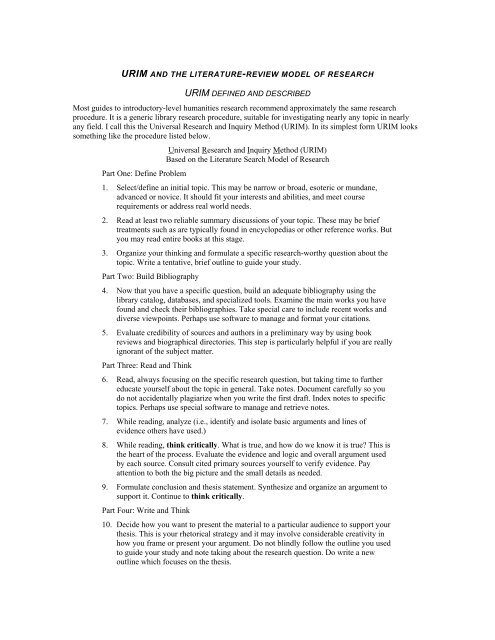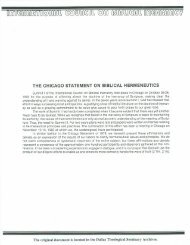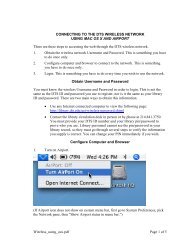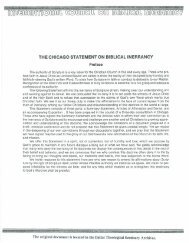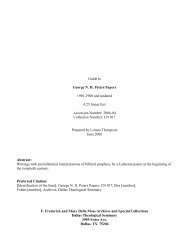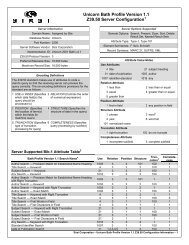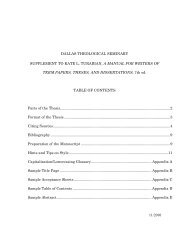URIM AND THE LITERATURE-REVIEW MODEL OF RESEARCH
URIM AND THE LITERATURE-REVIEW MODEL OF RESEARCH
URIM AND THE LITERATURE-REVIEW MODEL OF RESEARCH
Create successful ePaper yourself
Turn your PDF publications into a flip-book with our unique Google optimized e-Paper software.
<strong>URIM</strong> <strong>AND</strong> <strong>THE</strong> <strong>LITERATURE</strong>-<strong>REVIEW</strong> <strong>MODEL</strong> <strong>OF</strong> <strong>RESEARCH</strong><strong>URIM</strong> DEFINED <strong>AND</strong> DESCRIBEDMost guides to introductory-level humanities research recommend approximately the same researchprocedure. It is a generic library research procedure, suitable for investigating nearly any topic in nearlyany field. I call this the Universal Research and Inquiry Method (<strong>URIM</strong>). In its simplest form <strong>URIM</strong> lookssomething like the procedure listed below.Part One: Define ProblemUniversal Research and Inquiry Method (<strong>URIM</strong>)Based on the Literature Search Model of Research1. Select/define an initial topic. This may be narrow or broad, esoteric or mundane,advanced or novice. It should fit your interests and abilities, and meet courserequirements or address real world needs.2. Read at least two reliable summary discussions of your topic. These may be brieftreatments such as are typically found in encyclopedias or other reference works. Butyou may read entire books at this stage.3. Organize your thinking and formulate a specific research-worthy question about thetopic. Write a tentative, brief outline to guide your study.Part Two: Build Bibliography4. Now that you have a specific question, build an adequate bibliography using thelibrary catalog, databases, and specialized tools. Examine the main works you havefound and check their bibliographies. Take special care to include recent works anddiverse viewpoints. Perhaps use software to manage and format your citations.5. Evaluate credibility of sources and authors in a preliminary way by using bookreviews and biographical directories. This step is particularly helpful if you are reallyignorant of the subject matter.Part Three: Read and Think6. Read, always focusing on the specific research question, but taking time to furthereducate yourself about the topic in general. Take notes. Document carefully so youdo not accidentally plagiarize when you write the first draft. Index notes to specifictopics. Perhaps use special software to manage and retrieve notes.7. While reading, analyze (i.e., identify and isolate basic arguments and lines ofevidence others have used.)8. While reading, think critically. What is true, and how do we know it is true? This isthe heart of the process. Evaluate the evidence and logic and overall argument usedby each source. Consult cited primary sources yourself to verify evidence. Payattention to both the big picture and the small details as needed.9. Formulate conclusion and thesis statement. Synthesize and organize an argument tosupport it. Continue to think critically.Part Four: Write and Think10. Decide how you want to present the material to a particular audience to support yourthesis. This is your rhetorical strategy and it may involve considerable creativity inhow you frame or present your argument. Do not blindly follow the outline you usedto guide your study and note taking about the research question. Do write a newoutline which focuses on the thesis.
11. Compose draft. Present the truth as you understand it, being careful to evaluate allsignificant views fairly. Be logical. Document thoroughly and accurately as youwrite, not as an afterthought. Continue to think critically.12. Evaluate your work. Does the draft as a whole hang together and present a coherentargument for the thesis? Does each section advance the goal? Is it persuasive?Remember you are not just summarizing what you read; you are advancing apersuasive case to support a specific conclusion. Rewrite as needed, even if you mustreorganize or add new evidence and arguments.13. Edit for cohesion and accuracy. Polish and format.<strong>URIM</strong> is based on the literature search model of research. It calls for thoughtful reading, carefulunderstanding of sources, and honest consideration of a wide range of evidence and views. Everything isgeared to help the researcher interact with scholarly literature and critically evaluate each viewpoint. Oftenthis means weighing conflicting contradictory evidence and, if possible, identifying a viewpoint thatreasonably accounts for all evidence. Although <strong>URIM</strong> involves gathering and sifting information, the goalis not thoughtless collection of footnotes and quotations, or thoughtless regurgitation of what one has read.Information-gathering is a means, not the ends, and judicious, thoughtful, critical assessment of views andevidence is central. Communication is also important. <strong>URIM</strong> is designed to help the researcher produce acogent and well documented argument for a specific thesis, including fair assessment of evidence andarguments for and against the thesis.<strong>URIM</strong> EVALUATED<strong>URIM</strong> has some obvious virtues. It is conceptually and practically simple. It provides a starting point and aprocedure to follow. It is applicable to a wide range of topics and disciplines. It stresses critical thinking.<strong>URIM</strong> is a good way for a student to learn about a topic and to think through an issue. You have probablyfollowed a procedure much like <strong>URIM</strong> many times during your academic career. <strong>URIM</strong> has a place ingraduate studies and it can even be used with profit by mature scholars, although it was clearly designed forstudents and their needs.<strong>URIM</strong> has its proper role, but <strong>URIM</strong> is a poor guide for original research. Why so? 1) It looks for preexistinganswers in secondary literature. Pre-existing means not original. 2) It assumes a false linearprocess of inquiry. 3) It is a fixed recipe, an inflexible algorithmic approach to research. 4) It ignores therole of expertise and domain-specific problem solving techniques, and instead caters to generic researchtechniques.<strong>URIM</strong> LOOKS FOR PRE-EXISTING ANSWERS IN SECONDARY <strong>LITERATURE</strong><strong>URIM</strong> assumes the literature search model of research. It is based on finding pre-existing answers insecondary literature. It is the way to sift views and identify “the best known answer.” <strong>URIM</strong> is also acredible outline of how to do a critical literature review which shows strengths, weaknesses, and omissionsin the scholarly literature. It even allows for the possibility of a creative synthesis which adapts andmodifies prior views in small ways, although that is not its focus. However, it is not geared toward thescholar who is struggling to formulate an original and creative solution. It is not a guide to doing originalresearch with primary sources. But making an original contribution based on primary source data is the sinequa non of real research. So <strong>URIM</strong> does not meet the primary researcher’s greatest needs.<strong>URIM</strong> ASSUMES A LINEAR PROCESS <strong>OF</strong> INQUIRY<strong>URIM</strong> expects the researcher to proceed in a predetermined, smooth, linear progression from selection oftopic, to compilation of bibliography, to reading, thinking, and writing. But most real research ischaracterized by false starts, revision, and cyclic refinement at every stage of work, not by smooth linearprogression. Remember the hermeneutical circle! Research is rational but it is not linear.<strong>URIM</strong> IS A FIXED RECIPE<strong>URIM</strong> is a recipe, an algorithm. Research is rational but it is not algorithmic. No prepackaged procedure,no generic recipe can control the research process. Research involves a complex non-deterministic
interplay of data, method, assumption, analysis, synthesis, cleverness, thoroughness, and luck. Researchdoes not follow a fixed recipe, a deterministic algorithm.<strong>URIM</strong> IGNORES <strong>THE</strong> ROLE <strong>OF</strong> EXPERTISE <strong>AND</strong> DOMAIN-SPECIFICPROBLEM SOLVING TECHNIQUES<strong>URIM</strong> is a generic approach. <strong>URIM</strong> assumes hard work, clear thinking, and generic research techniques aresufficient. But <strong>URIM</strong> does not describe what expert researchers do. Expert original researchers almostinvariably depend very heavily on their knowledge of the specific problem and on specialized disciplinarymethods, models, theories, and canons of evidence. Generic research method is not the key. This issuemerits fuller development, so I will 1) explain what is meant by a generic problem solving technique, 2)explain what is meant by a domain-specific or subject-specific technique, and 3) describe how experts usedomain-specific techniques to solve many research problems. I believe this will help you see why a genericapproach like <strong>URIM</strong> does not describe original research although it does describe a part of what originalresearchers do.GENERIC PROBLEM SOLVINGI'm going to assume that generic research method is just a generic problem solving technique. Studies incognitive psychology and artificial intelligence have identified generic problem solving methods used byboth scholars and practitioners in a multitude of fields from physics to philosophy. But these same studieshave demonstrated that generic methods are inherently weak. 1 Specialized disciplinary (domain-specific 2 )methods tend to be more powerful.What does a generic method look like? The best known is means-ends analysis. The solver moves toward afinal solution by setting up subgoals, each of which is a means toward the final end. This involves breakingcomplex problems into smaller parts. Other well known general problem solving approaches and tacticsinclude working backwards, using qualitative representations (e.g., conceptual diagrams), trial and error,solving special cases before solving the general case, working with analogous problems, and using selfmanagementtechniques (e.g. self-questioning like “Why am I doing this?”)Mature scholars and researchers do use general/generic problem solving techniques. They especially usegeneral approaches when they are faced with atypical, novel or anomalous problems. The expert researcherwho is struggling with an anomaly partly resembles a novice in the way he works. Both expert and novicestruggle with false starts and circular procedures. Both rely on intuition, trial and error, etc. But domainspecificknowledge plays a very big role for the expert even when very general problem solving approachesare used. The specialized and the generic work together.DOMAIN-SPECIFIC PROBLEM SOLVINGWhat does a domain-specific problem solving method look like? Here are a couple of examples.Let’s start with something very simple and very familiar. Every seminarian learns a technique for doing NTlexical analysis. In simplest form it goes like this.1 D. N. Perkins and Gabriel Salomon ("Are Cognitive Skills Context-Bound," EducationalResearcher 18 [1989]: 16-25) provide a brief but excellent introductory survey of research into generalproblem solving methods and the role of domain-specific knowledge in problem solving. They advocate abalanced and nuanced view that recognizes both the value of general thinking skills and the essential role ofdomain-specific knowledge.2 "Domain" in this context refers to more than subject matter. It includes [distinctive] goals,methods, models, canons of evidence, and standards of performance used by its experts as well as subjectmatter. This sometimes implies what might be called sub-disciplines. "Palestinian archaeology" is anexample. The discipline/domain of expertise can be construed as narrowly or as broadly as needed to servethe problem at hand: Pauline studies; NT studies; Biblical studies; Christian theology, etc. We do not needa perfect definition of "domain" to understand the general point. But we do need to realize that domainmeans more than just subject matter. All of Second Century 1 (1981) is devoted to a debate of whether NTstudies constitutes a unified domain/discipline or a suite of allied domains/disciplines. It shows howscholars can construe both broadly and narrowly depending on the agenda.
Theory says every word normally has a broad semantic field, not a single meaning, and this semanticfield can be discovered by simply looking at examples of how the word is used. NT Greek is largelysecular Koine, and uses the stock lexicon.This theory suggests a certain procedure. First describe the entire semantic field of a word by studyingmany uses of the word and categorizing these examples. Note meaning may vary with literary genre,audience, date, and author. Then determine how the word is used in the particular context your arestudying.Apply standard canons of evidence to this procedure. For example, etymology is a poor guide tomeaning. Pre-Christian Koine examples of usage are a good guide to possible NT meaning butexamples far distant in time (classical period) are weaker evidence. Examples from the NT itself orfrom the same NT author are stronger still. Hundreds if not thousands of uses of a word may benecessary to represent the full semantic field. Remember to treat full phrases not just words inisolation. Allow for pregnant or technical uses of the words. A passage with synonymous orantithetical parallelism may provide a strong indication of how a word is used. Grammar and lexicalmeaning interact. Meaning may reside in the context that is not part of the meaning of the word per se.Do not read the entire context into the word. I suppose we could list 100 rules that apply here.The point I am making is that there is a theory, a procedure and canons of evidence. Every seminarianlearns this package; it is part of the very first course in exegesis. 3 Experts use domain-specific knowledgelike this as part of their problem solving strategies.Let’s look at a second example of domain-specific problem solving, this time from the field of ANEcomparative studies. 4 ANE discoveries sometimes contain striking similarities to (and differences from)biblical accounts. You are familiar with many examples. ANE texts have been used to illuminate thecreation accounts, the Flood narratives, covenant structure, biblical law codes, specific practices likeAbraham’s “sister-wife” lies, details of vocabulary and grammar, specific historical events, etc. You arealso familiar with false or at least unsupported claims some mature scholars have made when they failed tofollow basic rules and canons of evidence in using these sources (e.g. misuse of Babylonian sources byFriedrich Delitzsch, of Ugaritic tablets by Dahood, of Nuzi texts by Speiser, etc.)Let’s review some of the canons of evidence applicable to ANE comparative studies. Do not trust a single text; it is best to have multiple texts from multiple sites and time periods. Be very cautious about arguing from lack of ANE parallels; asserting the OT is “unique” may bearguing from silence. Superficial similarity does not prove deep similarity. Study both OT context and ANE context to showa custom or word has the same meaning in two different cultures. Similarity in some details does notprove similarity between whole systems. Note differences, not just similarities. Do not use a poorly understood feature of one culture to illuminate a poorly understood feature ofanother culture. A parallel from a distant culture/period is weak evidence. Do not compare apples with oranges. For example, do not compare one genre with another, like lawwith narrative. It is dangerous to date from customs or genre. At a minimum, you must have evidence from bothprevious and succeeding time periods. You must have extensive evidence, not just a few examples.Remember ANE documents had editions and revisions with different dates, and ideas existed earlierthan the documents.3 So students are typically exposed to textbooks like Stanley E. Porter, ed., Handbook to Exegesisof the New Testament (New York: Brill, 1997).4What is the comparative method as applied to ANE/OT studies? There are two main variations.1. Historical comparison. Similarities and differences between societies which belong to the same culturalcontext or historical stream are used to help us understand specific elements in the OT. This approachassumes that one culture influenced another or that both had common influences, and that ideas, rites, andcustoms spread. 2. Typological comparison. Similarities and differences between societies far apart in timeor space are used to help us understand universals, which are then in turn applied to specific elements in theOT, etc. This approach is sometimes associated with functionalist or structuralist anthropology.
So there are generally accepted canons of evidence that every student of the OT learns. A domain-specificapproach to problem solving makes use of domain-specific knowledge like this.EXPERT PROBLEM SOLVINGExperts usually solve problems using a disciplinary pool of standard methods, models, procedures, andcanons of evidence. Novices are unfamiliar or at least unskillful with these procedures, models, etc.Expertise consists more in knowledge than in native genius or clever use of generic problem solvingmethods. Experts possess vast disciplinary knowledge that enables them to quickly recognize andcategorize problems and to systematically work forward to solutions. Novices struggle not because they aredumb, not because they know nothing of general methods, but because they lack knowledge about theparticular subject area or the particular kind of problem.Knowledge is the single most important factor governing the work of experts when they solve problems. Ofcourse general intelligence, persistence, luck, appropriate use of general problem solving methods, andmany other factors also play important roles in research and problem solving. Subject knowledge is not theonly factor.Now the main point is this: at the broadest level, original research strategy is informed by, shaped by, evencontrolled by domain-specific knowledge. <strong>URIM</strong> ignores the crucial role of domain-specific knowledgeand expertise. <strong>URIM</strong> does not describe how expert researchers research. Specialized disciplinaryknowledge, methods, models, theories, and canons of evidence should be foremost. A generic approachcannot be domain-specific, much less problem-specific. <strong>URIM</strong> does not represent the broad pattern of realoriginal research.


